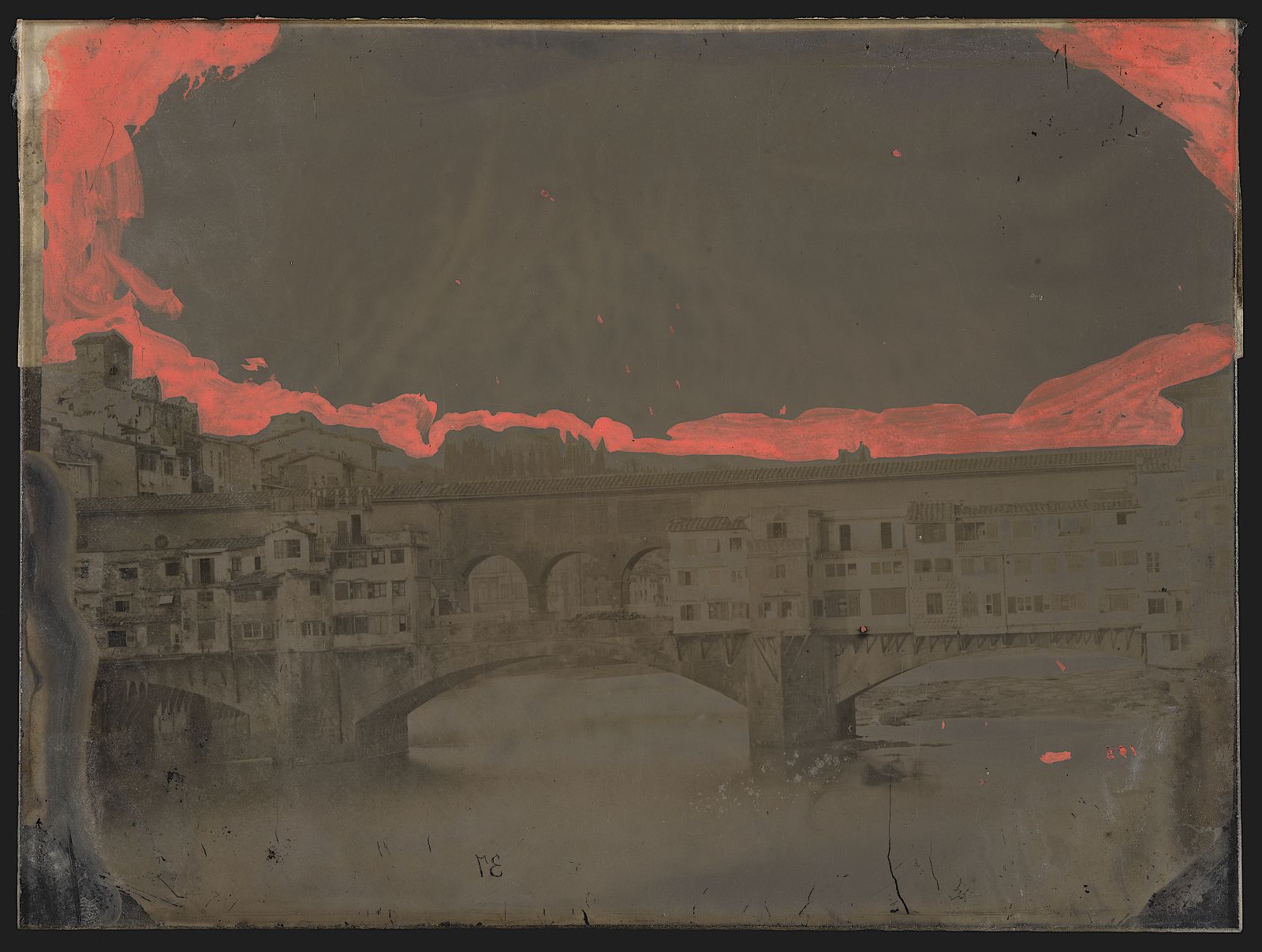Symposium
Building Bridges: Art Libraries’ Synergies and Strategies Between Florence and North America
A collaboration between the Kunsthistorisches Institut in Florenz – Max-Planck-Institut & Art Libraries Society of North America (ARLIS/NA). Organized by Margherita Naim (Kunsthistorisches Institut in Florenz) and Isotta Poggi (Getty Research Institute)

Anton Hautmann, Ponte Vecchio. General View from Lungarno degli Acciaiuoli, collodion glass negative, ante 1862, KHI Photothek.
This symposium is the culmination of a week-long study tour (October 22-27, 2023) in Florence for a group of twenty members of the Art Libraries Society of North America (ARLIS/NA). Founded in 1972, ARLIS/NA is dedicated to supporting the work of art libraries and their professional communities (https://www.arlisna.org/).
While art libraries can be distinct in profiles and mission, depending on whether they serve university programs in art history, museum curatorial departments, or research institutes with scholars and academics, they all share a deep commitment to preserving and providing access to the documentation of the cultural and artistic patrimony. This includes all its different formats and media, each with its challenges for preservation and access, from unique or rare holdings, to systems of visual records such as photographic archives, to collections of secondary literature.
In the context of our inter-continental exchange between the Americas and the city of Florence, a remarkable example of the impact of the work of art libraries is the collaborative research project around the Florentine Codex. The Codex, titled General History of Matters of New Spain, is an illustrated bilingual encyclopedic account —in Spanish and the Aztec Nahuatl language— on pre-Columbian Mexican culture and the early years of the Spanish conquest of Tenochtitlán (today’s Mexico City). Written in 1577, this codex possibly survived the censorship of the Spanish Crown by being gifted to the Medici in 1580, and is preserved to this day at the Biblioteca Medicea Laurenziana. In Florence this codex has been studied and published thanks to institutional collaborations between the Kunsthistorisches Institut in Florenz and Villa I Tatti which resulted in a conference and a publication Colors between two worlds on the pigments used in the manuscript (2008-2012). The Library of Congress in Washington DC added this UNESCO treasure to the World Digital Library; the Getty Research Institute in Los Angeles, has enhanced the digital version of the manuscript by providing translations in contemporary Spanish and English, recentering the voice of the indigenous communities.
After an enriching week of visits behind the scenes of exclusive Florentine cultural institutions, in primis the Kunsthistorisches Institut in Florenz which is the main host of the initiative, the presentations that follow highlight their work, challenges, and strategies in dialogue with diverse libraries —and their missions— across North America.
Funded with the support of:
ARLIS/NA International Relations Committee
Budini Gattai Family
Casalini Libri
Facsimile Finder
Kunsthistorisches Institut in Florenz – Max-Planck-Institut
A very special thanks to:
Alinari Foundation for Photography & Art Defender
Casalini Libri
European University Institute (EUI)
Florence National Central Library (BNCF)
Galileo Museum
Opificio delle Pietre Dure
Polimoda Library
Uffizi Art Library
Villa I Tatti, The Harvard University Center for Italian Renaissance Studies
Program
27 October 2023
14:00-14:30 Welcome (Gerhard Wolf, Costanza Caraffa and Jan Simane) & Introduction (Isotta Poggi and Margherita Naim)
Chair: Costanza Caraffa (Head of the Photothek, Kunsthistorisches Institut in Florenz)
14:30–14:50 – Keynote speaker: Roberto Ferrari, Director, Galileo Museum, Florence
Florence in Books, Collections and Institutions: a Cultural Texture
How is it possible to grasp the importance of knowledge exchanges developed in Florence and layered over the centuries, as we could experience today in libraries, museums, and archives of the city? Through the history of Museo Galileo Library, and some of its major projects, a cross-section of this “cultural texture” will be provided, to enlighten a possible actuality of this heritage.
Session I. Collaborations Across Boundaries
14:50–15:00 – Lisa Lamont, Digital Collections Librarian, San Diego State University, California, USA
Binational Library and Archives Projects: The Experience of the SDSU Library in Mexico
The SDSU Library is collaborating with two archives in Mexico, the Archivo Histórico de Tijuana and the Biblioteca de Investigación Juan de Córdoba in Oaxaca, to help digitize and describe their unique collections. The challenges are many, including the creation and display of multi-lingual metadata.
15:00–15:10 – Nina Bogdanovsky, Visual & Performing Arts Librarian, Boston College, Massachusetts, USA
Precious gifted collections: an example of collaboration between the library, university museum, academic departments, and students
Recently the McMullen Museum received two important gifts: 34 Antique Coptic textiles and the Lynch Collection of works by Picasso, Homer, Sargent, Cassatt, and others. The art works have been integrated into the teaching curriculum and the library collaborates with academic departments and the museum to create a comprehensive teaching and research collection.
15:10–15:20 – Jen Thomas, Book Art Program Director, University of Richmond, Virginia, USA
Integrating Book Arts Education into the Academic Classroom
The Book Arts Studio enriches the creative and scholarly culture at the University of Richmond by promoting the history and art of the book as a mode of communication, expression, and education. Jen will share course collaborations that center experiential learning opportunities across disciplines.
15:20–15:50 – Coffee Break
Chair: Jan Simane (Head of the Library, Kunsthistorisches Institut in Florenz)
15:50–16:10 – Keynote speaker: Josep Torn Poch, Library Director, European University Institute, Florence
Florentine Libraries as Hubs for National and International Relations: from the European University Institute Library to the Past
Florence as a home to a multitude of libraries that opened the world to the Florentines and Florence to the world is rich and varied. Beginning with Lorenzo the Magnificent's Library in the 15th century and culminating in the present-day Library of the European University Institute, a journey will be undertaken to explore significant milestones and the importance of the expertise of librarians in facilitating the exchange of information.
Session II. Art Access: Libraries Challenges and Strategies
16:10–16:20 – Margot McIlwain Nishimura, Dean of Libraries & Mark Pompelia, Visual and Material Resources Librarian, Fleet Library, Rhode Island School of Design, Providence, Rhode Island, USA
Visible Fleet: A Brief Review of Digitization Projects at RISD for Preservation, Discoverability, and Access
This presentation will share current efforts to make collections across RISD's Fleet Library more visible to the campus and the world. It will also explore how these efforts are surfacing and addressing concerns about the preservation of and access to unique and more unusual materials in RISD collections.
16:20–16:30 – Lori Salmon, Head, Institute of Fine Arts Library, New York University, New York, USA
NYU Libraries’ Institute of Fine Arts Library Special Collections
The Stephen Chan Library of Fine Arts collections reflect the research and curricular needs of New York University’s Institute of Fine Arts. Within the library’s distinctive holdings spanning four thousand years of recorded knowledge, researchers have access to materials in art history and archaeology. This presentation highlights the library’s most recent work in special collections, focusing on collection development, care, emergency planning, and promotion.
16:30–16:40 – Patricia Gimenez, Art Library Director, University of Iowa, Iowa City, USA
Two Years at the University of Iowa
As a first-time library director, Patricia Gimenez provides an overview of her first two years in the Art Library at the University of Iowa, a large public research institution. She will touch on the challenges of building new relationships with faculty, and will discuss a student-led outreach initiative, as well as a library shifting project that increases access to the quasi-rare materials in the collection.
16:40–17:10 – Coffee Break
Chair: Annalise Welte (Librarian for Research Services, New York University)
Session III. Art Research Tools
17:10–17:20 – Robyn Fleming, Museum Librarian, Thomas J. Watson Library, The Metropolitan Museum of Art, New York, USA
Unlocking a Legacy: Digitizing 150 Years of Metropolitan Museum of Art Publications
One aim of our library's digitization program is to digitize all publications created by The Metropolitan Museum of Art since its founding in 1869, including exhibition and collection catalogs, press releases, and ephemeral material. This presentation provides an overview of the collection, discussing some of the challenges and new opportunities as the collection grows and the technology matures.
17:20–17:30 – Christina Moretta, Photo Curator, San Francisco Public Library, California, USA
San Francisco through the Lens of Municipal Archives
The San Francisco History Center hosts the archives for the City & County of San Francisco which include over two million visual materials, ranging from tintypes to snapshots, glass plate negatives to digital files, photo albums to mug books. They cover San Francisco’s rich history from the 19th century urban growth through the late 20th century protests and social movements.
17:30–17:40 – Liv Valmestad, Head, Architecture/Fine Arts Library; Head, Humanities Division, Libraries, University of Manitoba, Winnipeg, Canada
Liv Valmestad: The Messy Librarian and Visual Literacy Instructor
As an “artist-scientist” wearing multiple hats as a creator, art historian, and art librarian, Valmestad provides students with the necessary tools for their academic toolbox. Through curiosity, intuition, process and reflection, her artistic self is always present in her approach to reference and teaching. Using the course EVDS Visual Literacy, Valmestad discusses how she supports the creators and their urge “to make.”
17:40–18:00 – Discussion
18.00 – Reception at the Palazzo Grifoni Budini Gattai Loggia (invite only)
27. Oktober 2023, 14:00 Uhr
This will be a hybrid event.
Venue
Palazzo Grifoni Budini Gattai
Via dei Servi 51
50122 Firenze, Italia
To participate in person please email margherita.naim@khi.fi.it to reserve your seat.
To participate online please register in advance via Zoom: https://eu02web.zoom-x.de/meeting/register/u5IvcemqrDgiHd0err4_er9Mv9Ege0ZFMpLl
After registering, you will receive a confirmation email containing information about joining the meeting.
Hinweis
Diese Veranstaltung wird durch Fotografien und/oder Videoaufnahmen dokumentiert. Falls es nicht Ihre Zustimmung findet, dass das Kunsthistorische Institut in Florenz Aufnahmen, auf denen Sie erkennbar abgebildet sein könnten, für die Veranstaltungsdokumentation und Öffentlichkeitsarbeit (z.B. Social Media) verwendet, bitten wir um eine entsprechende Rückmeldung.


